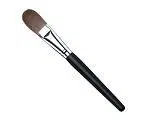Finding the etymological origin of the term brush leads us to have to go to Catalan, since it emanates from the word “pinzell”. This in turn emanates from the Vulgar Latin “penicellus”, which was the word used to refer to what was the tail of four-legged animals.
Paintbrush is an instrument that has a long, thin handle that, at one end, has a bunch of bristles, hairs or other filaments . The brush can be used to draw or paint: what you do is soak the bristles in paint or another similar substance and then slide them over the surface you intend to paint. The brush will be responsible for leaving a trace of paint.
Every brush has three fundamentals: the handle, the ferrule and the hair.
 For example: “I need to buy a new brush to paint the door frames” , “The artist has a collection of more than a thousand brushes because, once they are no longer useful, he keeps them as a souvenir” , “The drawing teacher “He asked us to bring brushes of five different sizes to class.”
For example: “I need to buy a new brush to paint the door frames” , “The artist has a collection of more than a thousand brushes because, once they are no longer useful, he keeps them as a souvenir” , “The drawing teacher “He asked us to bring brushes of five different sizes to class.”
The most important element of the brush is the hair. It can be natural animal hair or synthetic filaments . Depending on the hardness of these hairs, the brush will have different characteristics that will determine the possibilities it offers for painting or drawing. The less rigid hairs are those that allow softer and more delicate strokes.
Regarding the type of hair, it must be said that the most common brushes with animal hair are bristle, red sable and Kolinsky sable. The latter is considered the best hair and is therefore the most expensive, also taking into account that it comes from an animal that lives in northern Siberia and is in danger of extinction.
There are many different brushes, in terms of shapes, so that anyone who uses them can find the one that best suits their tastes, their tasks or their objectives. However, among the most significant are the following:
• Fan brush, which is mainly used to blend charcoal.
• Round tip brush, which is the one used to carry out tasks that require much more detailed and finer work.
• Cat's tongue brush, which is very useful for carrying out a wide variety of tasks as it perfectly combines the advantages of the round tip brush with those of the flat brush.
Another very important characteristic of the brush is its width. The wider the hair bundle, the thicker the strokes. This means that, to paint a wall in a single color , it is best to opt for very thick brushes, as it will make the job easier. On the other hand, for drawing, it is preferable to opt for finer brushes that allow you to develop all kinds of details. Certain intermediate brushes, meanwhile, are suitable for various tasks.
